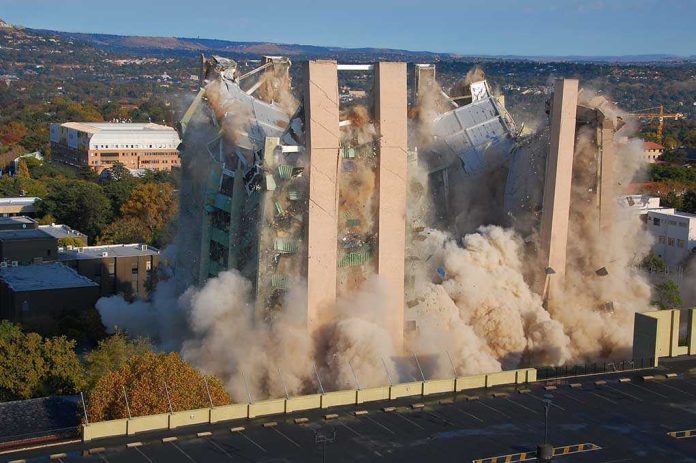
When a derelict Manchester building scheduled for demolition suddenly collapsed into the River Irwell, it exposed the razor-thin margin for error in urban demolition projects that can turn a controlled teardown into a citywide emergency in seconds.
Story Overview
- Alberton House partially collapsed during demolition due to scaffolding failure, forcing evacuation of 500 people
- No injuries reported despite debris falling into River Irwell and widespread panic among witnesses
- Emergency services immediately cordoned off Manchester city centre area near Bridge Street
- Building control authorities launched investigation into demolition safety protocols and contractor practices
The Moment Everything Went Wrong
At 2:50 PM on October 24, 2025, what should have been routine demolition work at Alberton House transformed into chaos. The scaffolding system supporting the derelict building failed catastrophically, sending portions of the structure crashing into the River Irwell below. Witnesses described feeling the ground shake, with many initially fearing an earthquake had struck Manchester’s bustling city centre.
The collapse occurred at St Mary’s Parsonage off Bridge Street, an area packed with commercial buildings and businesses. Within minutes, emergency sirens filled the air as Greater Manchester Fire and Rescue Service responded to what could have been a major disaster. The speed of the collapse left no time for warnings, making the absence of casualties nothing short of miraculous.
Mass Evacuation Creates Business District Ghost Town
Emergency responders immediately began evacuating surrounding buildings, ultimately displacing approximately 500 people from nearby business centres. The scale of the evacuation revealed just how densely packed Manchester’s city centre had become, with modern office complexes sitting mere meters from aging structures awaiting demolition. Workers poured onto streets, many clutching personal belongings and looking bewildered at the sudden disruption.
Local businesses faced immediate operational paralysis as authorities established safety perimeters around the collapse site. The evacuation highlighted a critical vulnerability in urban development strategies that place new investments adjacent to demolition zones. For hours, the normally bustling commercial district resembled a ghost town, with only emergency vehicles navigating the cordoned streets.
Investigation Reveals Systemic Safety Questions
Building control authorities quickly assumed control of the site from emergency responders, launching an investigation into the scaffolding failure that triggered the collapse. The incident raises uncomfortable questions about oversight of demolition contractors and the adequacy of safety protocols governing urban teardown projects. Manchester’s aggressive redevelopment agenda suddenly faced scrutiny over whether speed was being prioritized over safety.
The collapse of Alberton House represents more than an isolated construction accident. It exposes the inherent risks of conducting major demolition work in densely populated urban environments where a single failure can endanger hundreds of people and paralyze entire business districts. The investigation’s findings will likely influence demolition safety standards across Britain’s rapidly developing cities.















